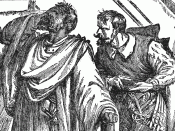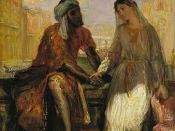This scene opens with Othello trying to justify his impending actions through his soliloquy as he stands over Desdemona whilst she is sleeping highlighting her innocence and vulnerability at this point. Shakespeare has Othello and Desdemona like this because to murder someone whilst they are asleep is the worst type of murder because they cannot defend themselves, an image not lost on the audience as Desdemona has not had the chance to defend herself throughout the play.
Othello's soliloquy is full of powerful images such as "the figure of justice" a rose" and "a carved alabaster effigy on a tomb".
This may be because Othello cannot face the reality of the role he is going to play (" the figure of justice" whom he plays in his mind), Desdemona the living women he loves (the "rose") and his intended act of murder (the reference to the "carved alabaster effigy on a tomb".)
So he uses these symbols for each one in an attempt to idealise the situation he has found him self in. It is to late for Othello to turn back and change his mind as his jealousy and anger overrides any other emotions such as thought and love. The audience would recognise this and feel that Desdemona must wake before Othello kills her in her sleep before she has had a chance 2 defend herself. When she does wake Shakespeare has Othello speak to her using religious language and references such as "I would not kill your soul", "Unreconciled as yet to heaven and grace, solicit for it straight" and "take heed of perjury: thou art on thy death-bed"
Shakespeare uses a lot of religious connotations throughout this scene, particularly in the lines 1-41. These religious connotations add to the sense of heightened atmosphere, dramatic irony and tension...
![From the Library of Congress: TITLE: Thos. W. Keene. Othello CALL NUMBER: POS - TH - 1884 .O7, no. 1 (C size) [P&P] REPRODUCTION NUMBER: LC-USZC6-58 (color film copy transparency) RIGHTS INFORMATION: No known restrictions on publication. MEDIUM: 1 print (](https://s.writework.com/uploads/9/94760/library-congress-title-thos-w-keene-othello-call-number-pos-thumb.jpg)


Pretty good
brings out pretty good points, however, needs more of an intro and a conclusion
6 out of 6 people found this comment useful.